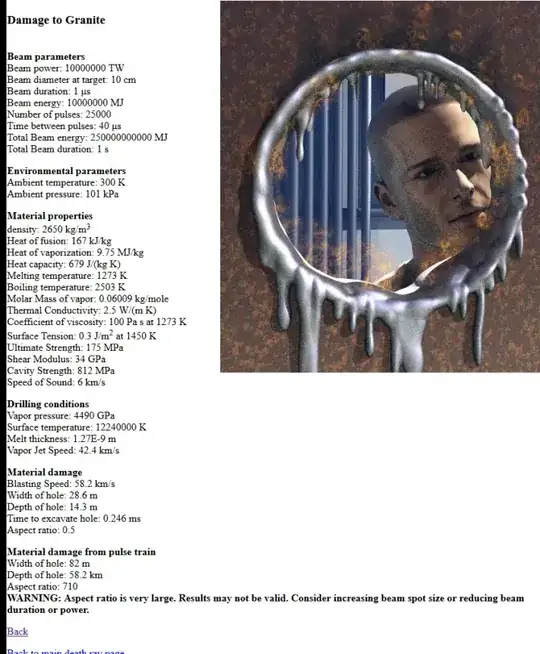High powered Lasers are useless
Thermal Blooming is a effect that renders a lot of laser systems useless. Basically, the laser gets deflected by the air and thus defocuses. Which in effect, makes it very inefficient at long ranges.
There are two ways you can counteract this effect. The first being just putting more power into the system. The second is to change the frequency of the laser.
Keep that in mind as we talk about your Laser.
Firstly, the cross section is important. Since it is portable, we can assume a lens with a radius of what 4cm or so. This means you have the Energy of N petajoules concentrated on an area 50cm². Now of course, N*petajoule is not very helpful measure. So lets go with 2 petajoules of energy for 50cm². Which gives you an energy density of 0.04 petajoules / cm².
How much energy is that? How much heat does this generate?
Well, this is where specific heat capacity comes into play. The heat capacity for air is basically 1, which is to be expected. Now we need the volume of air. For this we assume that the laser is a perfect cylinder with the base of 50cm². Light travels at 300,000,000,000 cm/s. Times that by * 0.1 and multiply by 50 and we get: 1,5*10^12 cm³. Which is 1,500,000 m³. The density of air is 1.225kg/m³. So we have 1,837,500 kg of air in our way.
So, the laser has to travel through 1.8 million kg of air.
How hot does it get ?
First we have to convert kg to g. So 1,873,500 * 1000 = 1,873,500,000 g. Then we just divide this by the joules. Again 2 petajoules are around 2e+15 joules. Thus we get 2e+15 / 1,873,500,000 = 1,067,520,683.
We then take this number and finally divide it by the heat capacity of air. It's capacity is 1 so the final heat output of this laser would be: 1.06 million degrees Celsius.
Now, is this realistic? No. This assumes that the laser would just appear and disappear instantaneously. But, no matter how you spin it, this is the ideal heat output. So in reality, it will be less.
Now 1.06 million Celsius might sound like a lot but remember, this is over a volume of 1.5 million m³. So the actual heat generated for each m³ is only 0.706 C. Not even a degree.
Again, this is not how it would look, in reality the laser beam would still cut through anything but the heat would be so stretched out over such a short period of time that not a lot would actually happen to the air around it. Only the tip would be a problem but it is travelling at lightspeed.
However, you can still assume that the tip of the beam would be around 1.06 million degrees.
1.06 Million degrees however, is nothing. Not a single element will start to fuse at those temperatures.
Going back
I mentioned before that thermal blooming and energy are a concern. And it still is. The good range of the laser might be anywhere around 10km or so. But it is very hard to tell. What is important is that just increasing the energy won't help a lot. At some point, you have to ask what sort of reactor people carry around with them to power it.
So in general, I'd say that the current laser is good enough. 2 petajoules will cut through anything.
End Result
The laser wouldn't do to much to the air around it. Everything that gets hit will have a bad day.
